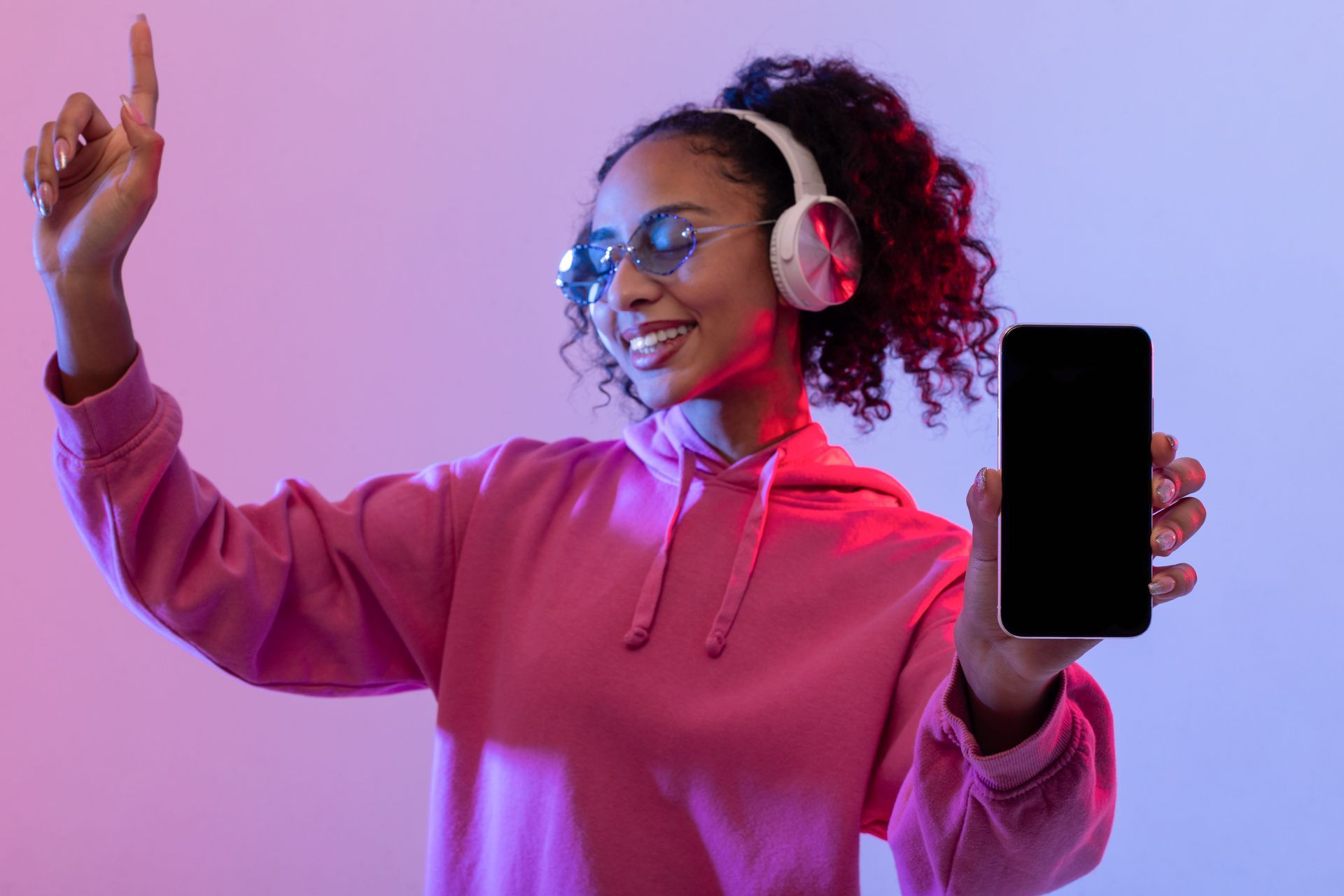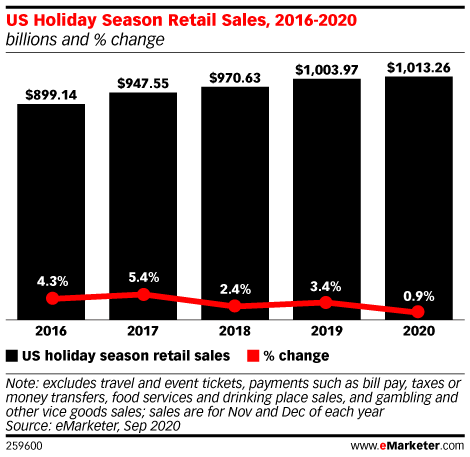The 5 Holiday Marketing Trends You Need to Know in 2020
‘Tis the season, albeit a very different season from the holidays we’ve previously experienced. Despite the ways consumers have adapted their shopping habits due to the pandemic, they still plan to keep the holiday feeling alive. Keep reading to learn more about the top holiday marketing trends and consumer insights you need to know in order to reach them effectively this year.
Here’s an overview of what we’ll be diving into:
- 1. Online Shopping Dominates
- 2, Digital Advertising Reigns Supreme
- 3. Messaging is Make or Break
- 4. Consumption is Up
- 5. Shopping Takes Place Earlier than Ever this Year
Questions? Contact us for more or check out our services.
1. Online Shopping Dominates
Given the ease and convenience of online shopping, especially in terms of the pandemic and safety concerns, it comes as no surprise that online shopping is expected to continue surging well into the holiday season.
According to
Oracle’s annual holiday survey, 58% of consumers say that they would consider shopping at an indoor or outdoor mall if "proper safety precautions" were implemented. Below are the measures that participants said they would want to be included in order to feel safe shopping in-person:
- 82% want to see visible cleaning and sanitation efforts.
- 79% want staff and customers to be wearing masks.
- 76% prefer limitations on how many people are allowed in stores at once.
- 6% of shoppers would like the option of contactless checkout.
- 39% said that "a lack of social distancing would cause them to have a bad shopping experience."
While shopping in-store is an option for some shoppers, it’s not even a consideration for many. It’s worthwhile for businesses of all sizes to at least offer online alternatives for consumers, or even shift in-store plans to go entirely online.
U.S. holiday e-commerce sales are projected to rise 33% year over year to $189 billion by the end of 2020, which equates to roughly two years of growth.
eMarketer currently predicts that brick-and-mortar sales—which will account for 81.2% of total US holiday retail—will decline 4.7% this holiday season, while ecommerce will increase by 35.8%.
2. Digital Advertising Reigns Supreme
Reach Consumers Where They’re Already At
With all of this talk of online shopping, how will consumers know about the deals taking place to begin with? The simple answer: digital advertising. As we’ve seen earlier this year, the pandemic has shifted many traditional advertising budgets to digital either partially or completely -- and for good reason.
Consumers have been spending more time at home, and many have had more time on their hands. Across the board, consumers have spent more time than they ever have on their digital devices across mobile, PC, and streaming devices. What better way to reach them than where they’re already spending the most time?
With in-person activities being frowned upon this year in light of health and safety risks, businesses will need to reimagine the way they typically host and celebrate holiday marketing events to stay competitive in the marketplace.
For instance, while the usual clamoring to get the best in-store Black Friday deals will be less likely, traditional in-person events may evolve to take on new forms online. This will also make Cyber Monday an even bigger online event than it has been in recent years.
Stay Up to Date with Search Trends for Key Consumer Insights
Online searches, both locally and at a broader level, will play a key role in understanding the top holiday trends that consumers are leaning towards this year. According to Search Engine Journal, the top holiday categories in order are:
- Collaboration and Teams
- Telehealth
- Online Learning
- Pet Adoption
- Garden and Patio
- Photography
- Consumer Electronics
- Gaming
- Streaming
- Video
- UI/UX
- Digital Transformation
- Document Management
- Online University
- Baby and Maternity
- Beauty
- Sports
- Apparel and Footwear
- Customer Experience and CRM
- IT Management
- 2020 Online Search Categories in Decline
Additionally, the below search categories are experiencing a decline this year:
- Things to Do
- Restaurants
- Health Topics
- Sporting Goods
- Hotels
- Flights
- Concerts
A Multichannel Approach is the Best Approach
It’s safe to say that most brands and businesses have at least considered the thought of a digital-focused holiday shopping experience this year -- and every business wants their slice of the ecommerce pie. That being said, adopting a multichannel approach to stay top of mind among consumers who are faced with plenty of brands and businesses to choose from can be vital.
For instance, businesses can deliver holiday offerings such as coupon codes across multiple channels such as email, text message, social media, etc. Any online space where consumers flock to is a potential opportunity to stand out to them as they move along their purchase journeys.
Don’t make the mistake of thinking that this year’s trends are a one-time occurence-- if there’s one takeaway you need to know about this digitally-fueled holiday season, it’s that 2020 will have a lasting effect on how consumers shop and behave. No matter where your company is at with its growth, online shopping preferences will likely prevail -- it’s up to you to keep up and adapt.
3. Messaging is Make or Break
After an unpredictable year, consumers are looking forward to a break and some sense of normalcy. Even if the usual holiday gatherings and events don’t take place, people are looking forward to the holiday season that they’re used to celebrating each year -- pandemic or not. Currently, 64% or participants in a recent survey reported that they are just as or more excited about the holidays this year.
According to this same survey, consumers have preferences for the ads they want to see in terms of whether they want ads to mention the pandemic. While 42% of consumers think holiday ads should reference COVID-19, 57% want ads that make them feel happy. 36% are looking for inspirational ads, 30% want ads to make them feel nostalgic, and 21% want to be amused. Lastly, 22% want to be informed, 17% want to be surprised, and 20% want ads to amaze them.
While being amazed may be a lot to ask for, simply tuning in to how consumers are feeling and how they’re facing hardships can go a long way. Given potential budget concerns, price and cost savings will play a big role for shoppers. Additional consumer preferences (in %) this year include:
- 44% -- Free and discounted shipping
- 40% -- Wide variety of products
- 44% -- Competitive prices and offerings
- 40% -- Ease of shopping
- 57% -- Searching online
- 53% -- Browsing online retailers Additional key findings include:
Holiday traditions will also influence the messaging and objectives of consumer shopping this year. For example,
50% of consumers in a recent survey said they plan to cook a traditional holiday meal for the upcoming holidays - making this good news for supermarkets and CPG brands.
Additionally, staying home with household members (77%) is ranked as the number one New Year’s activity people feel the most comfortable with. “Safe” Covid-19 activities such as drive-ins have experienced a renaissance, creating plenty of opportunities for brands and businesses to safely connect with consumers so long as they are able to get creative with their ideas. Not wanting to sacrifice their holiday traditions and the special aspects of the season, businesses who tap into the public’s desire for a “normal” (within reason) holiday season can win big this year.
Diversity and Inclusion Take on a Whole New Meaning in This Year’s Messaging
After a global pandemic and a racial reckoning in 2020, brands and businesses can benefit by making an effort to reach consumers of all backgrounds -- especially those in the multicultural market.
A recent
Facebook-commissioned survey
of U.S. participants found that only 41% feel represented in the ads they see - and 70% want to see more diversity and inclusion in digital ads. Those are a lot of people who are eager to see themselves and others represented in the content and ads they consume.
Even if you’re interested in diverse and inclusive marketing for your business, it can be daunting to go it alone. To learn more about the importance of multicultural marketing, check out our article
here, or read about
how to choose the perfect local marketing agency for your business.
Want to look at firsthand accounts of multicultural marketing and Hispanic marketing success stories? Head on over to our case studies for our examples!
4. Consumption is Up
A big difference in shopping this holiday season comes from the fact that consumers have more free time on their hands. With closures and stay-at-home activities being preferred, there’s ample time for them to browse and compare options.
For households with bigger incomes, or households that have more spending money to spare from limiting their spending in other areas as a result of the pandemic,
30% of respondents said they plan to spend more money online than last year this holiday season.
Another reason for possible increased spending this season is the possibility of another round of stimulus checks, making online shopping and increased spending even more likely. In the event that this happens, it’s
predicted that an additional $11 billion will be spent on online holiday shopping, bringing total sales to upwards of $200 billion.
5. Shopping Takes Place Earlier than Ever this Year
Most years, the start of the online shopping season begins with Black Friday sales, which then trickles into Cyber Monday sales. More recently, online shopping has begun shifting to Thanksgiving Day and earlier. This year in particular, Adobe Analytics expects the traditional“Cyber Week” (Thanksgiving through Cyber Monday) to turn into “Cyber Months.” As we’ve seen this year, the trends toward in-store pickup and curbside pickup are also expected to surge during the holidays.
This year’s Amazon Prime Day events, which took place online from October 13th-14th have provided insights for what holiday sales may potentially look like as well. An earlier-than-usual Prime Day showed that other
online retailers were focused on how they could shift customers from Amazon to their sites in order to not lose out.
It’s expected that Amazon's competitors will develop robust online deals and shopping options to maximize customer convenience, and emphasize their best qualities with unbeatable promotions and exclusive holiday deals. Last minute shopping is also much less likely this year. When asked when they plan to do the majority of their holiday shopping, 27% said November, 23% said Black Friday and Cyber Monday, and 17% plan to shop during the first half of December.
How to Get Started with Digital Marketing
Even though 2020 has been an unpredictable year, we have a much better idea of how the 2020 holiday season is shaping up thanks to insights from earlier this year that marked a huge shift to digital. With increased digital consumption and shopping methods, it’s no longer an added bonus to utilize digital marketing in your marketing strategy -- it’s a necessity.
Questions, comments, or interested in getting started? Feel free to
contact us, or find a
location near you
for a free consultation with one of our expert digital marketing consultants.
We look forward to hearing from you!
















